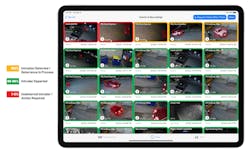This article originally appeared in the October 2022 issue of Security Business magazine. When sharing, don’t forget to mention Security Business magazine on LinkedIn and @SecBusinessMag on Twitter.
Video monitoring with Public Safety Answering Points (PSAP) dispatch services have been available for quite some time, touted as more cost effective than dedicated security guards. For some property owners who require improved security, it was still too expensive and not within budget; however, the value of video monitoring with active engagement and PSAP response has repeatedly proven to deter loitering and crime. Adoption of video monitoring will likely be exponential as we head into the future, with significant reductions in pricing predicted for the service.
A few of the challenges to cost-effectively deploy video monitoring include the balance between using artificial intelligence (AI) to filter out false positives and the increased possibility of missed detections, as well as the need for human effort to ultimately verify a positive intrusion.
There is no doubt that deep-learning AI remains the future for breakthroughs – i.e., cost reductions in video monitoring. Proper application of deep-learning AI has proven to successfully automate immediate deterrence of unwanted intrusions and focus operators on real threats and safety concerns that require intervention and possible PSAP dispatch.
Market Influencers
A confluence of factors continues to push the rise of video surveillance specifications, including smart cities, property crime, incidents of violence and an overarching need to better protect and safeguard facilities and occupants. Protecting the perimeter of the premises has never been more important, as property crimes continue to plague outdoor assets, including commercial properties, auto, tractor and heavy equipment dealerships, retail businesses, storage facilities, educational campuses, construction sites and more.
Incidents of theft and criminal activity are increasing and the losses staggering, with recovery rates minimal and elusive. Thieves are targeting air-conditioning units, electrical and plumbing components containing copper, building material, catalytic converters, fuel, vehicles, and heavy equipment in brazen attacks. Dumpster diving and loitering on commercial properties and construction sites create liabilities and insecure environments.
For a building owner, property manager, dealership, or campus, handling theft, intrusion and the resulting damage can be costly. Time matters. Crimes occur in seconds, and deterrence actions must be swift and effective.
According to FBI crime data, in 2020 stolen property loss in the U.S. was estimated at $971 billion vs. a recovered value of $54 billion and recovery rate of 5.6%. The general burglary trend in 2022 is also heading upward as evidenced by reports from the New York Police Department (NYPD) and Chicago Police Department (CPD) where burglaries have increased 32.7% and 35% respectively in same period comparisons of 2022 to 2021. Catalytic converter thefts are the latest wave of targeted crime. In 2021, there were 52,206 catalytic converter thefts across the U.S., up 1,215% from 2019, according to the National Insurance Crime Bureau, a trend that has only accelerated in 2022.
The value proposition of RVM is clear: deterrence of crime before it happens.
Enter Deep-Learning AI
There is significant potential in using deep-learning AI to not only automate deterrence of intrusion but also to improve the efficiency of the human labor required to monitor video. The immediate gains of deep learning AI in RVM are a faster reaction to intrusion, driving down monitoring labor costs.
Automating deterrence with randomized and unpredictable actions offers an immediate response to intrusion which is proven to both thwart unwanted intrusion and reduce the frequency of intrusions on that property. Further, deep-learning technology is suitable to characterize successful deterrence events and focus the attention of monitoring personnel on events that require their attention. The overarching goal is being able to reduce RMV costs, which leads to more attractive RMR pricing for the property owner and ultimately an exponential increase in demand for video surveillance services.
Upon review of tens of thousands of recorded intrusions on commercial properties, we have proven that training convolutional neural networks (CNN) to detect and classify intrusions coupled with automated deterrence that reacts with immediacy achieved 99% success without the need for human engagement. In deep learning, CNN is a class of artificial neural network most often applied to analyze visual imagery.
Development teams are training CNN algorithms within the AI application to accurately and quickly detect both intrusion and persistent loitering for use in fully automating proportional deterrence reactions. And equally important, we have ascertained the distinct characteristics of a successful deterrence event which has been extremely useful in shaping our understanding of when it is important to engage human intervention, and of course, when it is needless.
Innovation in deep learning AI and other automated detection processes are now effectively reducing the labor to monitor cameras – critical to market growth as surveillance continues to proliferate. RVM is purpose built to automate detection and deterrence, proving 99% effective in eliminating loitering and crime. And just as important, automation has reduced the cost burden and added significant value to monitoring. Culled data combined with machine learning continually tailors to the environment, so the latest algorithms yield superior detection.
AI is a Game Changer for RVM
Deep-learning AI is the future of visual security and video monitoring. The next level of evolution in RVM technology brings additional opportunity for security providers to enter the market with significantly lower costs resulting in greater market adoption and higher returns on their sales efforts. Leveraging AI technologyA conceptual illustration of a human interface designed to focus operator attention to urgent matters (see the illustration on the right) would be simply to highlight visually, in red outline, the events that are classified as intruders who persist regardless of the automated deterrence actions. Likewise, intrusions that were classified as successfully deterred and not requiring human engagement would be highlighted in green and moved below the fold. Finally, intrusions in the process of receiving active deterrence actions would be highlighted in yellow, awaiting the final AI classification of successfully deterred or remaining undeterred.
More Choices for Detection
RVM with fully automated and intelligent deterrence and detection can be flexibly configured to meet end-user needs and business requirements. For example, it can suspend all monitoring activities during normal business hours or continue to simply monitor and record pedestrian and vehicle traffic. After business hours or late in the evening, the system can welcome guests or customers with a soft message accompanied by a slight increase in the LED illumination for safety. As the night progresses, the system can be used to inform front desk staff that a customer has arrived, pop-up a live video feed and activate a series of LED lights to establish a direct and safe path to the front entrance. The immediate reception is welcoming to guests, whereas intruders, looking to break into a vehicle or commence other criminal activity, will know they have been noticed.
RVM innovation helps provide proactive and directed response. It relieves stress on 911 dispatch by sending video files verifying activity before initiating first responders and providing better threat monitoring, situational awareness and incident response. With innovation in RVM, systems integrators can provide a proven RMR value proposition to the end-user.






